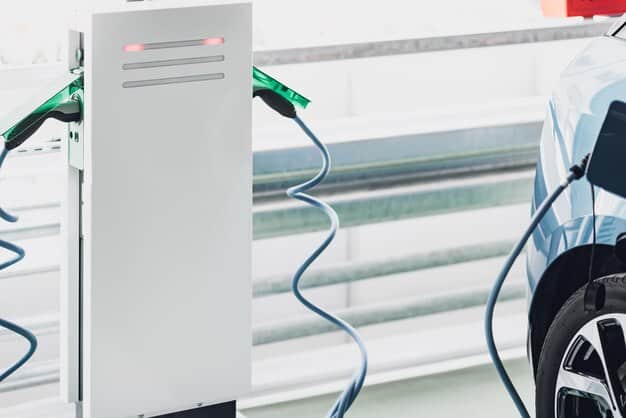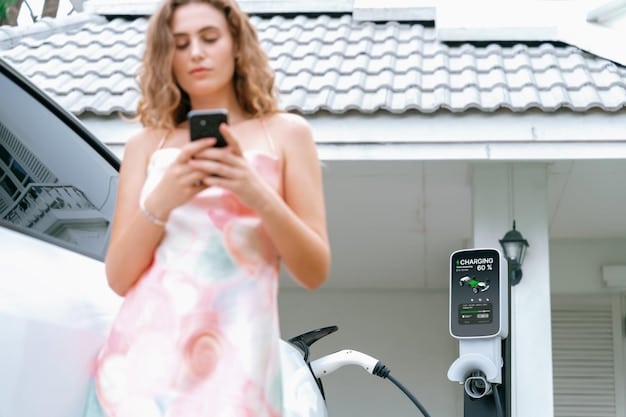Maximize EV Battery Life & Charging Speed by 20%: Tips & Tricks

Electric Vehicle Charging: How to Maximize Battery Life and Reduce Charging Time by 20% explores practical strategies for EV owners to enhance battery longevity, optimize charging practices, and implement techniques that can significantly reduce charging times while preserving battery health.
Are you looking to get the most out of your electric vehicle? Understanding how to optimize your **electric vehicle charging: how to maximize battery life and reduce charging time by 20%** can significantly improve your EV experience, saving you time and money.
Understanding EV Battery Technology
Electric vehicle (EV) batteries are at the heart of what makes these vehicles run, and understanding their technology is crucial for effective charging and longevity. The most common type of battery found in EVs is the lithium-ion battery, known for its high energy density and relatively long lifespan.
Types of EV Batteries
Several variations of lithium-ion batteries are used in EVs, each with its own advantages and disadvantages. These include Nickel Manganese Cobalt (NMC), Nickel Cobalt Aluminum (NCA), and Lithium Iron Phosphate (LFP) batteries. NMC and NCA batteries offer high energy density, while LFP batteries are known for their thermal stability and longer lifespan.
Factors Affecting Battery Life
Numerous factors can impact the lifespan of an EV battery. These include charging habits, ambient temperature, and usage patterns. Extreme temperatures, both hot and cold, can degrade battery performance over time. Similarly, consistently charging the battery to 100% or depleting it to 0% can put unnecessary stress on the battery cells.
- Temperature: Extreme heat and cold can accelerate battery degradation.
- Charging Habits: Frequent fast charging and deep discharges can reduce battery life.
- Usage: Aggressive driving habits can increase battery wear and tear.
Ultimately, understanding the technology behind your EV battery and being mindful of these factors can help you prolong its life and maintain optimal performance.

Optimizing Charging Habits for Longer Battery Life
One of the most straightforward ways to extend the life of your EV battery is to optimize your charging habits. Simple changes in how and when you charge can make a significant difference in the long run.
Ideal Charging Practices
To maximize battery longevity, it’s generally recommended to keep your battery charge between 20% and 80%. This range avoids the stresses associated with both full and near-empty charges. Frequent, smaller charges are often better than infrequent, full charges.
Avoiding Extreme Charging
Minimize the use of DC fast charging unless necessary for long trips. While convenient, fast charging generates more heat, which can degrade the battery over time. Instead, opt for Level 2 charging at home or work whenever possible.
- Stay within 20-80% Range: Avoid full and deep discharges.
- Use Level 2 Charging: Prefer slower, gentler charging methods for daily use.
- Limit Fast Charging: Reserve DC fast charging for when you really need it.
By adopting these charging practices, you can reduce the strain on your EV battery and help it last longer, potentially saving you money on replacements in the future.
Reducing Charging Time: Practical Strategies
While extending battery life is crucial, reducing charging time is equally important for convenience. Several strategies can help you charge your EV faster without compromising battery health.
Upgrading Charging Equipment
Investing in a Level 2 charger for your home can significantly reduce charging times compared to using a standard Level 1 charger. Level 2 chargers provide higher voltage and amperage, allowing for faster charging rates.
Optimizing Charging Conditions
Charging your EV in moderate temperatures can also speed up the process. Extreme cold can slow down charging, as the battery management system may limit the charging rate to protect the battery. Pre-conditioning the battery before charging can help in cold climates.

- Install Level 2 Charger: Upgrade from Level 1 for faster home charging.
- Maintain Moderate Temperatures: Charge in a temperature-controlled environment.
- Use Battery Pre-Conditioning: Warm up the battery before charging in cold conditions.
By improving your charging setup and managing charging conditions, you can decrease the amount of time your EV spends plugged in and increase your overall driving convenience.
The Role of Battery Management Systems (BMS)
Battery Management Systems (BMS) play a critical role in both extending battery life and optimizing charging. These sophisticated systems monitor and control various aspects of the battery to ensure safe and efficient operation.
How BMS Works
A BMS monitors factors such as voltage, current, and temperature of individual battery cells. It then adjusts charging and discharging rates to prevent overcharging, over-discharging, and overheating. This helps to maintain the health and balance of the battery pack.
Benefits of a Well-Functioning BMS
A properly functioning BMS can significantly extend battery life, improve vehicle performance, and enhance safety. It prevents damage to the battery cells and ensures that the battery operates within safe limits.
The BMS is an integral component of **electric vehicle charging: how to maximize battery life and reduce charging time by 20%**.
Understanding the BMS and its functions can give you confidence in your EV’s safety and longevity. Regular maintenance and software updates for the BMS are essential for optimal performance.
Software Updates and Battery Performance
Software updates are not limited to infotainment systems; they also play a vital role in managing and improving battery performance in EVs. Manufacturers often release updates that optimize charging algorithms, thermal management, and overall battery efficiency.
Importance of Regular Updates
Staying up-to-date with the latest software releases ensures that your EV is running the most efficient and effective battery management algorithms. These updates can address known issues, improve charging times, and extend battery life.
How Software Updates Impact Charging
Software updates can fine-tune the way your EV charges, optimizing the charging curve to reduce stress on the battery. They can also improve the accuracy of range estimates and provide more detailed information about battery health.
- Improved Charging Algorithms: Reduce stress on battery cells.
- Enhanced Thermal Management: Protect against overheating and cold.
- More Accurate Range Estimates: Provide better insights into remaining range.
Regularly checking for and installing software updates is a simple yet effective way to keep your EV’s battery performing at its best. These updates are often free and can be installed via over-the-air updates or at a service center.
Future Trends in EV Charging Technology
The field of EV charging technology is constantly evolving, with numerous innovations on the horizon. These advancements promise to further reduce charging times, extend battery life, and improve the overall EV ownership experience.
Wireless Charging
Wireless charging is an emerging technology that allows EVs to charge without the need for cables. Vehicles can simply park over a charging pad, and energy is transferred wirelessly via inductive charging. This offers a convenient and seamless charging experience.
Advanced Battery Chemistries
Researchers are continually exploring new battery chemistries that offer higher energy density, longer lifespans, and improved safety. Solid-state batteries, for example, are a promising alternative to traditional lithium-ion batteries, offering increased energy density and enhanced thermal stability.
- Wireless Charging: Convenient and cable-free charging solutions.
- Solid-State Batteries: Higher energy density and improved safety.
- Ultra-Fast Charging: Technologies to significantly reduce charging times.
Staying informed about these emerging trends can help you make informed decisions about your EV and its charging needs. As technology advances, expect even more efficient and convenient ways to charge your electric vehicle.
| Key Point | Brief Description |
|---|---|
| 🔋 Battery Health | Optimize charging between 20-80% to extend battery life. |
| ⚡️ Charging Speed | Use Level 2 chargers for faster and more efficient charging. |
| 🌡️ Temperature | Avoid extreme temperatures when charging to protect the battery. |
| 🔄 Software Updates | Keep your EV’s software updated for optimized battery performance. |
Frequently Asked Questions (FAQ)
▼
It’s best to charge your EV frequently in smaller increments, keeping the battery level between 20% and 80% for optimal battery health. Avoid letting the battery drain completely.
▼
Frequent use of DC fast charging can degrade the battery over time due to the heat generated. Use it sparingly for long trips and rely on Level 2 charging for daily needs.
▼
Yes, extreme temperatures can impact charging. Cold weather can slow charging rates, while hot weather can cause the battery to overheat. Try to charge in moderate temperatures.
▼
A Level 2 charger uses a 240-volt outlet and can charge your EV much faster than a standard 120-volt Level 1 charger. It’s ideal for home or workplace charging.
▼
Software updates optimize charging algorithms and thermal management, improving overall battery efficiency and extending battery life. Always keep your EV software up-to-date.
Conclusion
By implementing these strategies, you can significantly enhance the longevity of your EV battery while also reducing charging times. Following these tips will not only improve your overall EV experience but also contribute to a more sustainable future.





